Waterloo, UK
Waterloo, a district in Central London, is situated 1.6 km east of Charing Cross on the south bank of the Thames opposite the City of Westminster. The area is part of a business improvement district which includes The Cut and the Old Vic and Young Vic theatres. It includes some sections of the London Borough of Southwark.
The area was marshland towards the northern tip of the ancient parish of Lambeth. It was known as Lambeth Marshe, but was drained in the 18th century and is remembered in the Lower Marsh street name.
Waterloo station (also known as London Waterloo) and its approach viaducts, dominates the locality. The station is a central London terminus on the National Rail network in the United Kingdom, in the Waterloo area of the London Borough of Lambeth. It is connected to a London Underground station of the same name and is adjacent to Waterloo East station on the South Eastern Main Line. The station is the terminus of the South West Main Line to Weymouth via Southampton, the West of England main line to Exeter via Salisbury, the Portsmouth Direct line to Portsmouth Harbour which connects with ferry services to the Isle of Wight, and several commuter services around west and south-west London, Surrey, Hampshire and Berkshire.
Plan and Book:


About Waterloo
Waterloo is connected to the Strand area on the north bank of the River Thames by Waterloo Bridge. The first bridge on the site was opened in 1817 and the current bridge was opened in 1945. The bridge was named to commemorate the Battle of Waterloo in 1815. Waterloo Road also dates from this time, built on land belonging to the Archbishop of Canterbury. St John's, Waterloo was constructed from 1822 by the Commissioners for Building New Churches as the population of the parish of Lambeth had significantly increased.
After the opening of Waterloo railway station in 1848 via the Nine Elms to Waterloo Viaduct the locality around the station and Lower Marsh became known as Waterloo. The boundary of the ecclesiastical parish of St John Waterloo established in 1824 was formed by the River Thames in the north and west, approximated Westminster Bridge Road in the south, and followed the boundary with Southwark in the east.
The public library in Waterloo was constructed in 1893. It remained open until the early 1960s when it was vacated due to its poor condition. The building now houses the Waterloo Action Centre.
The Catholic St Patrick's Church was built in 1897 and designed by Frederick Walters. Roupell Street is noted for its well-preserved Georgian housing and is often used as a TV and film location.
Waterloo Station
Waterloo Station was opened in 1848 by the London and South Western Railway, and it replaced the earlier Nine Elms as it was closer to the West End. It was never designed to be a terminus, as the original intention was to continue the line towards the City of London, and consequently the station developed in a haphazard fashion, leading to difficulty finding the correct platform. The station was rebuilt in the early 20th century, opening in 1922, and included the Victory Arch over the main entrance, which commemorated World War I. Waterloo was the last London terminus to provide steam-powered services, which ended in 1967. The station was the London terminus for Eurostar international trains from 1994 until 2007, when they were transferred to St. Pancras.
Waterloo is the busiest railway station in the UK, handling 41 million passengers in the year to March 2022. It is also the UK's largest station in terms of floor space and has the greatest number of platforms.
Waterloo and Southwark are known for their many bridges and viaducts which carry numerous railway lines through the area, dominating the landscape. One of the reasons the Waterloo Station and its track are supported by so many arches is to stop the enormous site falling into the marshland on the banks of the Thames throughout the years.
A single track link used to exist between Waterloo and the line out of Charing Cross. The link was constructed in 1864 though was never heavily used. At that time it carried a short-lived Cannon Street – Kensington (Addison Road) service, and then was later used for a Willesden Junction – Waterloo service run by the LNWR. When the main station was completely rebuilt in stages from south to north between 1900 and 1922, the spur disappeared in 1911 as part of this process.
HG Wells made reference to this link in his book "War of the Worlds" published in 1897. The Martians had arrived at Horsell Common near Woking and were starting to emerge from their pit. Train services were beginning to get disrupted by the advance of the aliens and fighting was breaking out. The relevant paragraph reads: "About five o'clock the gathering crowd at Waterloo station was immensely excited by the opening of the line of communication, which is almost invariably closed, between the South-Eastern and South-Western stations, and the passage of carriage-trucks bearing huge guns , and carriages crammed with soldiers. These were the guns that were brought up from Woolwich and Chatham to cover Kingston...." etc.
The Vaults
The Vaults of Leeke Street behind Waterloo Station were creted to store bodies waiting to be transferred by train via the Mecropolis railway to Rookwood Cemetery. Today the walls of the vaults are used as a canvas by steet artists. Atvthe end of the tunnel is Lower Marsh, named because the area was originally marsh land. Immediately opposite the tunnel entrance is the site of the Canterbury Music Hall (next to the railway bridge). Known as the Father of Music Halls, it was destroyed in a World War II bombing raid in 1942.

Westminster Bridge House (above) on Westminster Bridge Road was the entrance to London's Mecropolis Rilway Station. The bodies of the dead were brought up in lifts to the pltform level, from where mourners and coffins began their journey to Rookwood Cemetery where the funerals were held.
Southwark
History and modernity collide in this central London neighbourhood. Its
varied architectural styles tell stories of London's past and hint at
its future. Southwark's tunnels serve grander purposes than simple
passers-by passageways. Old brick warehouses line the Thames,
indicative of London's industrial past. Some have been remodelled into
ultra-modern marvels.
Like the perfect pot of afternoon tea, Southwark has been culturally
steeping for centuries. The neighbourhood is home to many of the
city’s iconic landmarks—London’s most famous bridges,
buildings, and museums are located in Southwark. Crisscross the Thames
via the Tower, Millennium, or London bridges and be rewarded with
panoramic views of history abutting modernity—Southwark boasts
Shakespeare’s Globe Theatre, the Tate Modern museum,
London's famous Borough market, and myriad pubs and restaurants.
Bankside
Bankside is one of the oldest settlements in Britain, dating back
over 6000 years. When the Romans founded Londinium on the north bank of
the Thames, a bridge was built near the present day London Bridge, and
the surrounding area has been inhabited ever since. The main
entertainments that drew crowds to Bankside were the 'stewhouses'
(brothels), animal-baiting pits and public theatres, sometimes all at
once. The Rose, the Swan, the Globe and the Hope were the four Bankside
playhouses of the Tudor era, and some of the first ever in London. Some
of England's greatest writers and players, including William
Shakespeare, lived and worked here.

Theatres aside, the area of the Thames between Blackfriars Bridge and
London Bridge was also known to freeze over in exceptionally cold
winters and Londoners used to take to the ice for all manner of
activities in what were known as Frost Fairs. During the late 18th
century Bankside quickly developed into an industrial environment, with
docks, warehouses and wharves. Following industrial decline after the
Second World War it remained largely undiscovered, until its recent
renaissance as one of the capital's prime visitor destinations.
Bankside's great feat of planning has been to join up individual
attractions to make one exciting coherent destination, accessible from
the City via the Millennium Bridge and forming a natural riverside
extension to the east of the South Bank. The area is refreshingly
pedestrian friendly and every time you turn a corner another cultural
highlight reveals itself.
Elephant and Castle
The Elephant and Castle is an area around a major road junction in South London. The name also informally refers to the areas of Walworth and Newington, the proximity of the London Underground station of the same name has led to the area being more commonly called "Elephant and Castle". The name is derived from a local coaching inn. 'Newington' is one of the most common place names in England, and from 1750 the area became more important and the informal name, from the pub at this junction, was adopted. In the middle of the former northern roundabout, now Elephant Square, is the Michael Faraday Memorial, a large stainless steel box built in honour of Michael Faraday, who was born nearby. It contains an electrical substation for the Northern line of the London Underground. Famous former residents include actors Charlie Chaplin and Michael Caine, and and actress and television presenter Lisa Maxwell, who were born and grew up locally, as well as renowned Particular Baptist preacher Charles Spurgeon and poet and playwright Robert Browning.
Lambeth
Not one, but two, bridges connect Lambeth to its across-the-Thames
counterparts. This central London neighbourhood blends high culture and
pub culture with ease—Lambeth boasts its own palace to rival
Westminster’s, as well as gold-gilded taverns that supply modern
libations in old-world watering holes. Unpretentious and readily
accessible, this brick and stucco neighbourhood puts you in the middle
of London without having to bear the crowds. Lambeth Palace is the
official London residence of the Archbishop of Canterbury. For more
culture the Old Vic and Imperial War Museum are also nearby. Lambeth's
riverbank perch provides stunning views of The Houses of Parliament and
Big Ben.

Oppopite Lambeth North Station is Lincoln Memorial Tower. Built in 1876, it commemorates US President Abraham Lincoln. Stars and strpes have been incorporated into the brickwork of the spire. Once part of a complex of nineteenth-century philanthropic institutions sited alongside Christ Church Congregational chapel, it is all that now remains of the original design. Much of the Christ Church complex was destroyed in the Second World War, although the Lincoln Tower survived. The tower was opened on 4 July 1876, the centenary of American independence.

Naval officer, explorer, commander of HMS Bountry and Governor of NSW, Willim Bligh (1754-1817) lived at 100 Lambeth Road, Lambeth. Governor of New South Wales, 1806-08, he was laid to rest in a family plot at St. Mary's, Lambeth (this church is now the Garden Museum). The Garden Museum, formerly known as the Museum of Garden History, is based in the deconsecrated parish church of St Mary-at-Lambeth in Lambeth, adjacent to Lambeth Palace on the south bank of the River Thames in London, located on Lambeth Road.

Grave of William Bligh

